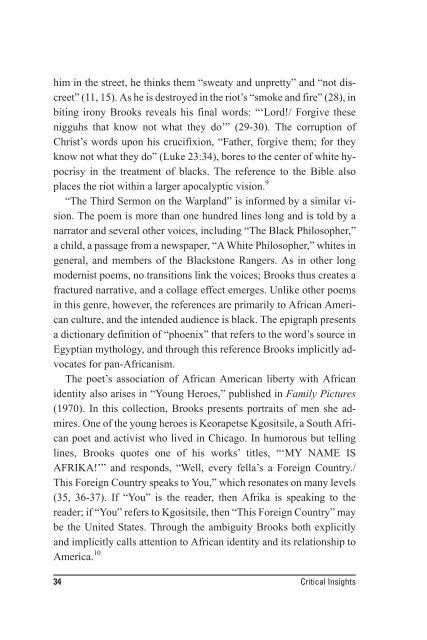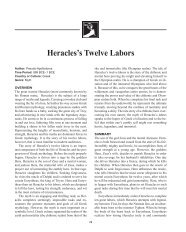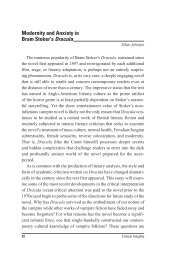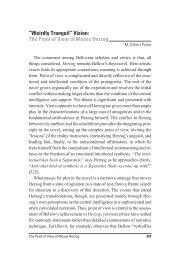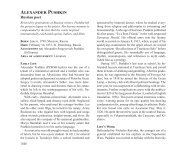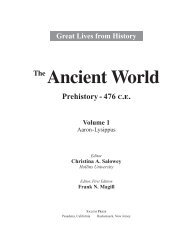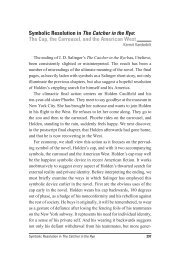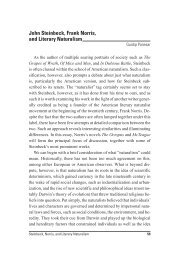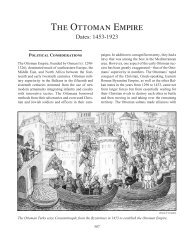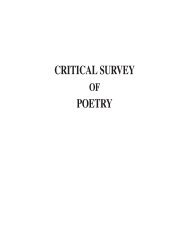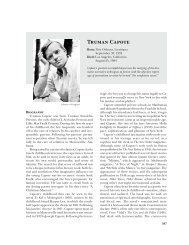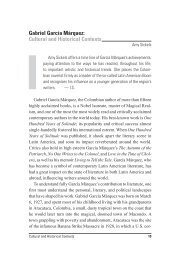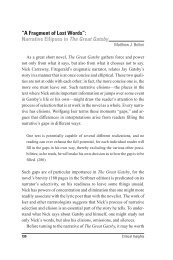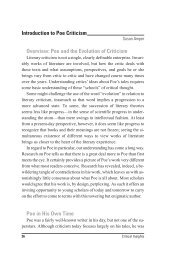The Historical and Social Context of Gwendolyn ... - Salem Press
The Historical and Social Context of Gwendolyn ... - Salem Press
The Historical and Social Context of Gwendolyn ... - Salem Press
Create successful ePaper yourself
Turn your PDF publications into a flip-book with our unique Google optimized e-Paper software.
him in the street, he thinks them “sweaty <strong>and</strong> unpretty” <strong>and</strong> “not discreet”<br />
(11, 15). As he is destroyed in the riot’s “smoke <strong>and</strong> fire” (28), in<br />
biting irony Brooks reveals his final words: “‘Lord!/ Forgive these<br />
nigguhs that know not what they do’” (29-30). <strong>The</strong> corruption <strong>of</strong><br />
Christ’s words upon his crucifixion, “Father, forgive them; for they<br />
know not what they do” (Luke 23:34), bores to the center <strong>of</strong> white hypocrisy<br />
in the treatment <strong>of</strong> blacks. <strong>The</strong> reference to the Bible also<br />
places the riot within a larger apocalyptic vision. 9<br />
“<strong>The</strong> Third Sermon on the Warpl<strong>and</strong>” is informed by a similar vision.<br />
<strong>The</strong> poem is more than one hundred lines long <strong>and</strong> is told by a<br />
narrator <strong>and</strong> several other voices, including “<strong>The</strong> Black Philosopher,”<br />
a child, a passage from a newspaper, “A White Philosopher,” whites in<br />
general, <strong>and</strong> members <strong>of</strong> the Blackstone Rangers. As in other long<br />
modernist poems, no transitions link the voices; Brooks thus creates a<br />
fractured narrative, <strong>and</strong> a collage effect emerges. Unlike other poems<br />
in this genre, however, the references are primarily to African American<br />
culture, <strong>and</strong> the intended audience is black. <strong>The</strong> epigraph presents<br />
a dictionary definition <strong>of</strong> “phoenix” that refers to the word’s source in<br />
Egyptian mythology, <strong>and</strong> through this reference Brooks implicitly advocates<br />
for pan-Africanism.<br />
<strong>The</strong> poet’s association <strong>of</strong> African American liberty with African<br />
identity also arises in “Young Heroes,” published in Family Pictures<br />
(1970). In this collection, Brooks presents portraits <strong>of</strong> men she admires.<br />
One <strong>of</strong> the young heroes is Keorapetse Kgositsile, a South African<br />
poet <strong>and</strong> activist who lived in Chicago. In humorous but telling<br />
lines, Brooks quotes one <strong>of</strong> his works’ titles, “‘MY NAME IS<br />
AFRIKA!’” <strong>and</strong> responds, “Well, every fella’s a Foreign Country./<br />
This Foreign Country speaks to You,” which resonates on many levels<br />
(35, 36-37). If “You” is the reader, then Afrika is speaking to the<br />
reader; if “You” refers to Kgositsile, then “This Foreign Country” may<br />
be the United States. Through the ambiguity Brooks both explicitly<br />
<strong>and</strong> implicitly calls attention to African identity <strong>and</strong> its relationship to<br />
America. 10<br />
34 Critical Insights


